David Lang is writing about
"Using the
MT-LXX Parallel" in Accordance. If you use Accordance, you definitely want
to check it out.
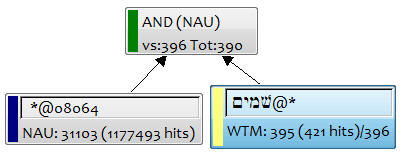
Run the search, and you will see this in the results:
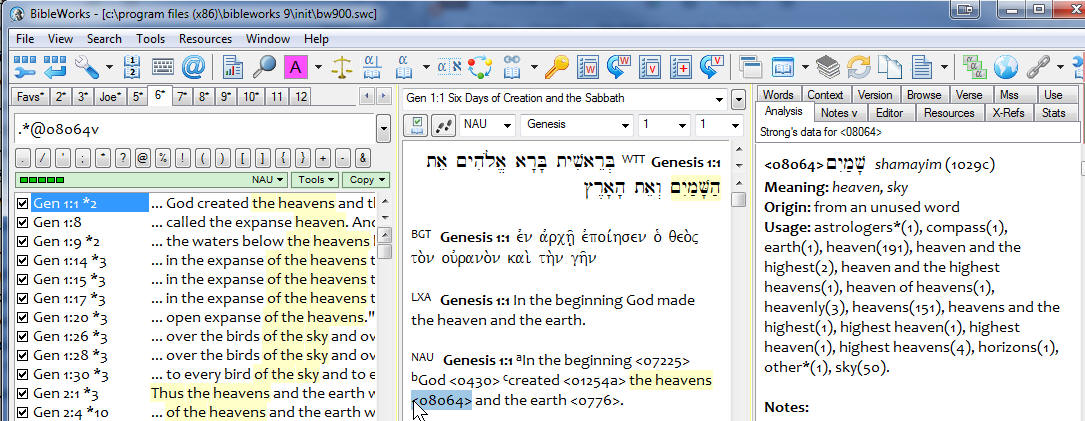
This does let you see both words highlighted, but it only works with the MT and either the KJV or NASB (the only versions with Strong's coding). When hovering the mouse over the Strong's number, you can also see in the Analysis tab the usage statistics. Like Accordance, this kind of matched visual highlighting will not work for Hebrew MT and Greek LXX. So, similarly, BW9 offers Tov's Parallel Hebrew and LXX. (Click on the little icon with the Greek alpha and Hebrew aleph or find it under the Resources in the menu line.) Doing so will give you this:
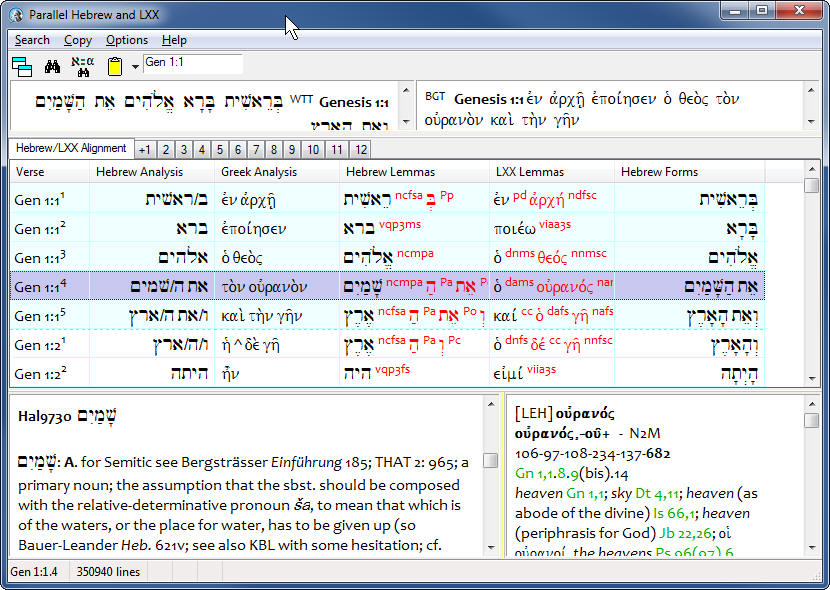
One thing that should be noted here is that both the Hebrew and Greek are morphologically tagged. This will make it easier to answer Lang's question, "Find every place where the LXX translates the Hebrew word tselem by some form of the word eikon."
There are a number of ways to do this in BibleWorks.
- First, Lang shows how Accordance has linked the Hebrew MT and the Greek LXX with English versions so that hovering over a Hebrew or Greek word will highlight the English word. He uses the example in Genesis 1.1 of שָּׁמַיִם and οὐρανὸν. The problem, however, is that though you can see the relationship of Hebrew>English and Greek>English, you cannot see the relationship between the Hebrew and Greek
- To see the connection between the Hebrew and Greek, Lang shows how to use the "MT-LXX Parallel" tool. (I'm assuming this is Tov's work or one similar to it.) This tool matches up each word in the Hebrew with the word(s) used to translate it (or not!) in the LXX.
- Since the Hebrew is not tagged in that resource, Lang then shows how to use a MERGE command to handle searches like: "Find every place where the LXX translates the Hebrew word tselem by some form of the word eikon." (This is the word usually translated in Genesis 1.26 with "image.")
BibleWorks9
As an example, how is שָּׁמַיִם translated in the LXX and English versions? There is no easy way to see this visually in BibleWorks. The closest option I can think of is to find that the Hebrew word is assigned 08064 in Strong's. You could then use the Graphical Search Engine and search for this:
Run the search, and you will see this in the results:

This does let you see both words highlighted, but it only works with the MT and either the KJV or NASB (the only versions with Strong's coding). When hovering the mouse over the Strong's number, you can also see in the Analysis tab the usage statistics. Like Accordance, this kind of matched visual highlighting will not work for Hebrew MT and Greek LXX. So, similarly, BW9 offers Tov's Parallel Hebrew and LXX. (Click on the little icon with the Greek alpha and Hebrew aleph or find it under the Resources in the menu line.) Doing so will give you this:

One thing that should be noted here is that both the Hebrew and Greek are morphologically tagged. This will make it easier to answer Lang's question, "Find every place where the LXX translates the Hebrew word tselem by some form of the word eikon."
There are a number of ways to do this in BibleWorks.
- You could use the Graphical Search engine and conduct a search like
this:
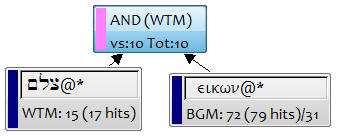
In .08 seconds it will generate the 11 hits that match. Hmmm.... Lang came up with 26 or so hits. What's going on? It turns out that Tov's Parallel Hebrew-Greek does not distinguish between the Hebrew and Aramaic parts of the OT, but BibleWorks does separate them. And there a whole bunch of "images" in the Aramaic parts of Daniel! So, yourhttp://www.scrollandscreen.com/biblestudyresources/http://www.scrollandscreen.com/biblestudyresources/ Graphical Search engine query needs to look like this:
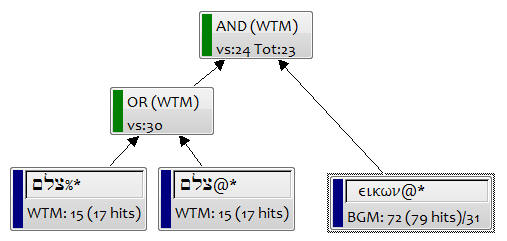
(Note that the percentage sign % following the root indicates Aramaic and the at@ sign indicates Hebrew. If you want the QF file of this search, HERE it is.) Now I get the 30 hits in 23 verses in 0.14 seconds. This is good, but... it's not necessarily what you want. It's actually searching for verses where the Hebrew/Aramaic word appears and the Greek word also appears. It does not necessarily mean that the Greek is translating that particular Hebrew word. -
Another way you might answer our question is by using Tov's Parallel again and take advantage of BW's morphological tagging of it. Click on the little binoculars with the א=α above it. When it opens, you can type in the Hebrew root, start the search and you will get this:
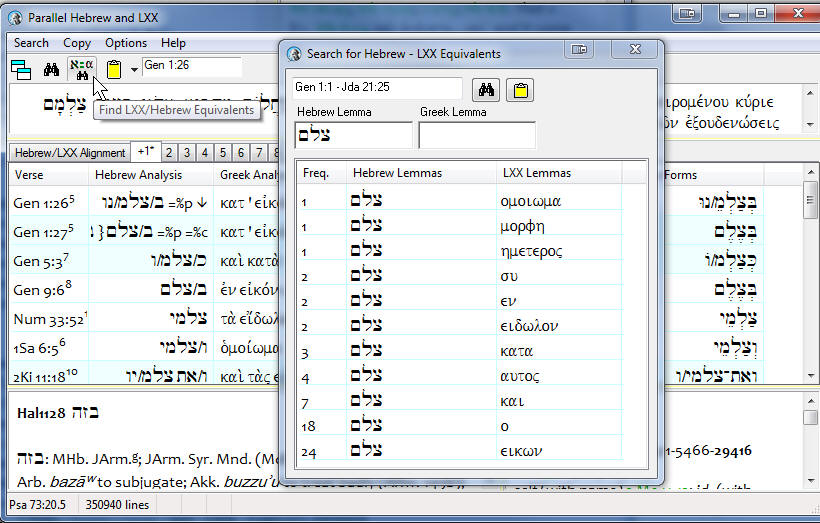
This is a good way to look at all the ways that a Hebrew root is rendered in Greek (or, conversely, how a Greek lemma is rendering the Hebrew), but you also see that the results will need some closer inspection. (You see that the article or conjunctions or prepositions are sometimes listed. This is an issue w/ how Tov categorized things.) -
SO, HERE IS THE BEST SOLUTION! Click on the line with the words you are interested in, and then click on the bigger binoculars in Tov, and the Alignment Search Window will appear. Now you can search according to particular Forms or Analysis or Lemmas. For the specific question we were asking, I did a little editing of the fields so that my search looked like this. (Note which boxes I checked.)
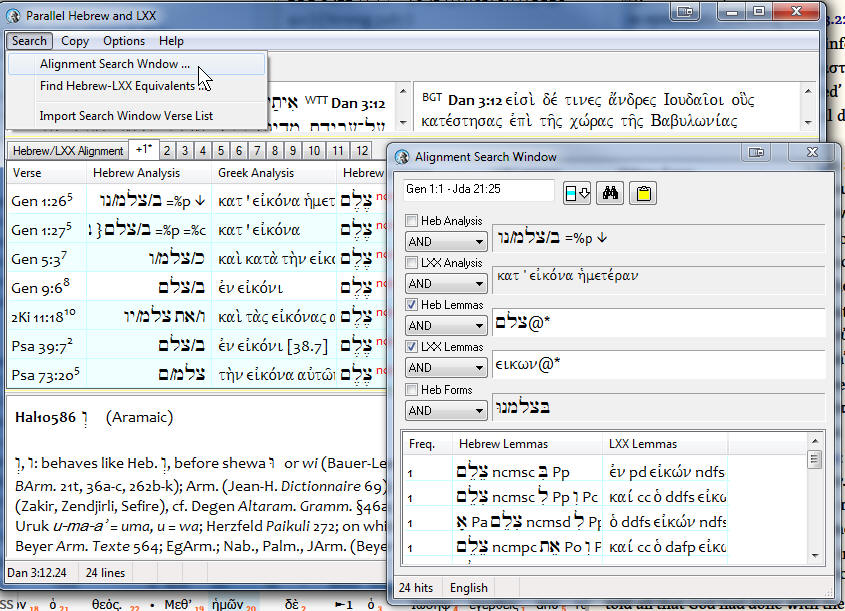
The search takes a bit longer, but it gives exactly the results I want. I can also easily select all my results, send them to the main BW search window, and then generate a list of verses I want: Gen 1:26, 27; 5:3; 9:6; 2Ki 11:18; Psa 39:7; 73:20; Eze 7:20; 16:17; 23:14; Dan 2:31, 31, 34, 35; 3:1, 2, 3, 5, 7, 10, 12, 14, 15, 18.
Note that this is also the better way to generate all the instances of Hebrew>Greek or Greek<Hebrew. Unfortunately, I don't see any easy way of extracting and synthesizing the results to get the numbers of times a Hebrew word is being translated by particular Greek words.
- CONS:
- There is no visual link of Hebrew, Greek, and English in the normal display mode.
- There is not easy way to extract a count of how a Hebrew word is rendered by Greek words or a count of what Hebrew words are being translated by a Greek word.
- PROS:
- BW offers a number of ways of working with the texts.
- BW's implementation of Tov's parallel Hebrew and Greek is notable for its morphological tagging which allows for powerful searching capabilities.
- It's easy to generate lists of verses that match search criteria.








No comments:
Post a Comment